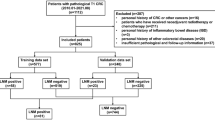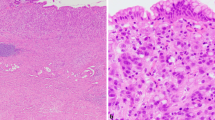Abstract
Tumor size has been included into the staging systems of many solid tumors, such as lung and breast. However, tumor size is not integrated in the staging of gastric cancer, and its prognostic value for gastric cancer needs to be reappraised. A total of 2,379 patients who received radical resection for histopathologically confirmed gastric adenocarcinoma were enrolled in the present study. Tumor size, originally presented as continuous variable, was categorized into small gastric cancer (SGC) group and large gastric cancer (LGC) group using an optimal cutoff point determined by Cox proportional hazards model. The associations between tumor size and other clinicopathological factors were checked using Chi-square test. Survival of gastric cancer patients was estimated by using univariate Kaplan–Meier method, and the survival difference was checked by using the log-rank test. The significant clinicopathological factors were included into the Cox proportional hazards model to determine the independent prognostic factors, and their hazard ratios were calculated. With the optimal cutoff point of 4 cm, tumor size was categorized into SGC group (≤4 cm) and LGC group (>4 cm). Tumor size closely correlated with age, tumor location, macroscopic type, Lauren classification, and lymphatic vessel invasion. Moreover, tumor size was also significantly associated with depth of tumor invasion and status of regional lymph nodes. The 5-year survival rate was 68.7 % for SGC group which was much higher than 40.2 % for LGC group. Univariate analysis showed that SGC had a better survival than LGC, mainly for patients with IIA, IIB, and IIIA stage. Multivariate analysis revealed that tumor size as well as age, tumor location, macroscopic type, Lauren classification, lymphatic vessel invasion, depth of tumor invasion, and status of regional lymph nodes were independent prognostic factors for gastric cancer. Tumor size is a reliable prognostic factor for patients with gastric cancer, and the measurement of tumor size would be helpful to the staging and management of gastric cancer.


Similar content being viewed by others
References
Ferlay J, Shin HR, Bray F, Forman D, Mathers C and Parkin DM. GLOBOCAN 2008 v1.2, cancer incidence and mortality worldwide: IARC CancerBase no. 10 [Internet]. Lyon, France: International Agency for Research on Cancer; 2010. Available from: http://globocan.iarc.fr, accessed on 1/6/2012.
Yang L. Incidence and mortality of gastric cancer in China. World J Gastroenterol. 2006;12(1):17–20.
Kim JP, Lee JH, Kim SJ, Yu HJ, Yang HK. Clinicopathologic characteristics and prognostic factors in 10 783 patients with gastric cancer. Gastric Cancer. 1998;1(2):125–33.
Siewert JR, Böttcher K, Stein HJ, Roder JD. Relevant prognostic factors in gastric cancer: ten-year results of the German Gastric Cancer Study. Ann Surg. 1998;228(4):449–61.
Mohri Y, Tanaka K, Ohi M, Yokoe T, Miki C, Kusunoki M. Prognostic significance of host- and tumor-related factors in patients with gastric cancer. World J Surg. 2010;34(2):285–90.
Japanese Gastric Cancer Association. Japanese classification of gastric carcinoma: 3rd English edition. Gastric Cancer. 2011;14(2):101–12.
Edge SB, Byrd DR, Compton CC, Fritz AG, Greene FL, Trotti A, editors. American Joint Committee on Cancer, American Cancer Society: AJCC cancer staging manual. 7th ed. New York: Springer; 2010.
Wang X, Wan F, Pan J, Yu GZ, Chen Y, Wang JJ. Tumor size: a non-neglectable independent prognostic factor for gastric cancer. J Surg Oncol. 2008;97(3):236–40.
Giuliani A, Caporale A, Di Bari M, Demoro M, Gozzo P, Corona M, Miccini M, Ricciardulli T, Tocchi A. Maximum gastric cancer diameter as a prognostic indicator: univariate and multivariate analysis. J Exp Clin Cancer Res. 2003;22(4):531–8.
Saito H, Osaki T, Murakami D, Sakamoto T, Kanaji S, Oro S, Tatebe S, Tsujitani S, Ikeguchi M. Macroscopic tumor size as a simple prognostic indicator in patients with gastric cancer. Am J Surg. 2006;192(3):296–300.
Adachi Y, Oshiro T, Mori M, Maehara Y, Sugimachi K. Tumor size as a simple prognostic indicator for gastric carcinoma. Ann Surg Oncol. 1997;4(2):137–40.
Xu CY, Shen JG, Shen JY, Chen WJ, Wang LB. Ulcer size as a novel indicator marker is correlated with prognosis of ulcerative gastric cancer. Dig Surg. 2009;26(4):312–6.
Yokota T, Ishiyama S, Saito T, Teshima S, Yamada Y, Iwamoto K, Takahashi M, Murata K, Yamauchi H. Is tumor size a prognostic indicator for gastric carcinoma? Anticancer Res. 2002;22(6B):3673–7.
Kunisaki C, Makino H, Takagawa R, Oshima T, Nagano Y, Kosaka T, Ono HA, Otsuka Y, Akiyama H, Ichikawa Y, Shimada H. Tumor diameter as a prognostic factor in patients with gastric cancer. Ann Surg Oncol. 2008;15(7):1959–67.
Jun KH, Jung H, Baek JM, Chin HM, Park WB. Does tumor size have an impact on gastric cancer? A single institute experience. Langenbecks Arch Surg. 2009;394(4):631–5.
Otsuji E, Kuriu Y, Ichikawa D, Ochiai T, Okamoto K, Yamagishi H. Prediction of lymph node metastasis by size of early gastric carcinoma. Hepatogastroenterology. 2007;54(74):602–5.
Aoyama T, Yoshikawa T, Watanabe T, Hayashi T, Ogata T, Cho H, Tsuburaya A. Macroscopic tumor size as an independent prognostic factor for stage II/III gastric cancer patients who underwent D2 gastrectomy followed by adjuvant chemotherapy with S-1. Gastric Cancer. 2011;14(3):274–8.
Liu X, Xu Y, Long Z, Zhu H, Wang Y. Prognostic significance of tumor size in T3 gastric cancer. Ann Surg Oncol. 2009;16(7):1875–82.
Bilici A, Uygun K, Seker M, Ustaalioglu BB, Aliustaoglu M, Temiz S, Aksu G, Gezen C, Yavuzer D, Kaya S, Salepci T, Mayadagli A, Gumus M. The effect of tumor size on overall survival in patients with pT3 gastric cancer: experiences from 3 centers. Onkologie. 2010;33(12):676–82.
Yokota T, Kunii Y, Saito T, Teshima S, Yamada Y, Iwamoto K, Takahashi H, Takahashi M, Kikuchi S, Yamauchi H. Prognostic factors of gastric cancer tumours of less than 2 cm in diameter: rationale for limited surgery. Eur J Surg Oncol. 2002;28(3):209–13.
Li C, Oh SJ, Kim S, Hyung WJ, Yan M, Zhu ZG, Noh SH. Risk factors of survival and surgical treatment for advanced gastric cancer with large tumor size. J Gastrointest Surg. 2009;13(5):881–5.
Conflicts of interest
None.
Author information
Authors and Affiliations
Corresponding author
Rights and permissions
About this article
Cite this article
Guo, P., Li, Y., Zhu, Z. et al. Prognostic value of tumor size in gastric cancer: an analysis of 2,379 patients. Tumor Biol. 34, 1027–1035 (2013). https://doi.org/10.1007/s13277-012-0642-6
Received:
Accepted:
Published:
Issue Date:
DOI: https://doi.org/10.1007/s13277-012-0642-6




